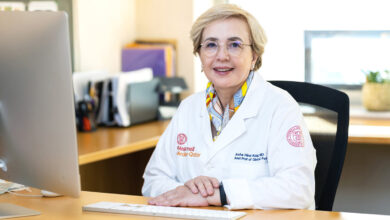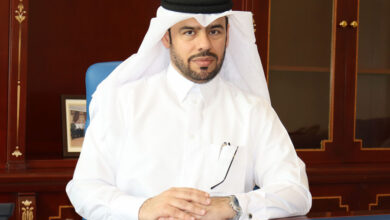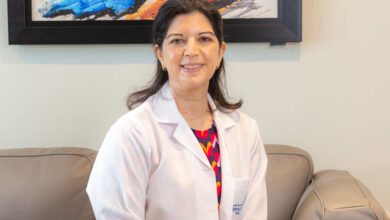Carine Haddad
Healthcare Manager for OKI – MEIT
Carine Haddad
“We present the first Laser-LED printers with embedded DICOM protocol worldwide”

OKI is a pioneer in innovative print technologies from digital LED to High Definition Colour. It delivers unbeatable accuracy and precision printing for the medical industry. ‘Hospitals’ magazine had a comprehensive interview with Carine Haddad, Healthcare Manager for OKI in the Middle East, India and Turkey.
It’s well known that OKI Europe delivers unbeatable accuracy and precision printing for the medical industry. Can we have a brief about the company’s history? Its portfolio? And how it was integrated into the healthcare sector?
OKI is one of Japan’s pioneering manufacturer of telecommunication equipment, we started back in 1881 when its founder Kibataro Oki manufactured and established Japan’s first telecommunications equipment and made the nation’s first telephone. The long heritage of over 130 years makes us immensely proud and gives us considerable stability. OKI produced the world’s first digital LED printer in 1981, amongst other key innovations that continue till this day. OKI has a portfolio of A3 and A4 office printers and multifunction printers for every size of business and workgroup, to expand beyond the 4 walls of the office, and to be a one-stop shop for different sectors. Our vision is to address the individual concerns and challenges of our customers, transform their businesses and enable new streamlined digital processes for greater efficiency and productivity.
As OKI takes the printing solutions deeper into verticals, we have a unique range of specialist products; including Retail, Graphics and the first LED DICOM-embedded (DMe) A4 and A3 printers which enables direct printing from the medical equipment and machines without software or hardware. The medical printers can also be used for the general admin use, so can save having two separate devices.
What is the medical equipment’s offered by OKI Europe?
OKI presents the first Laser-LED printers with embedded DICOM protocol worldwide, offering fully specialized printing solutions targeted at the healthcare market.
The DICOM (Digital Imaging and Communications in Medicine) protocol is used worldwide for the management, storage, transmission and printing of medical material. OKI’s A4 and A3 printers fully incorporate the DICOM protocol, and require no further installation of external drivers or print servers.
OKI’s DICOM series consists of one A4 (ES6410DMe) and two A3 (ES8431DMe and Pro9431DMe)colour printers. Robust, flexible and easy to use, they are ideal for hospitals and clinics, as well as for dental and veterinarian clinics. They can print medical files including X-rays, MRIs, ultrasound scans, etc., in High Definition, for uses such as patient records kept by doctors, or for the patient’s own copy of their medical records, and other near-diagnostic purposes. At the same time, they are suitable for ordinary office use, facilitating medical and ordinary print-outs from a single device, saving space and reducing the cost of maintenance and supplies.
The healthcare sector is one of the fastest-growing industries in the world, can you tell us about the services and solutions that you offer in this field?
The healthcare industry is becoming increasingly complex, with providers being asked to deliver quality care, ensure patient safety and improve operations at a time when budgets are under pressure.
We are offering a cost-effective printing output that can now help the customers to save up to 70% less than traditional medical images, with added color capacity and warranty for 3 years. Paper can be annotated which allows the radiologist to write his own comments and print directly from the modality or PACS.
In addition, paper as a printing material, compared to the materials previously used in medical printing, is more environmentally friendly and more easily stored and archived. Because of its durability, it protects medical prints from the risk of deterioration due to exposure to the sun or to moisture.
The value-added feature which created a difference at our most digitized customers and helped them to consider and invest in our DICOM products is when technology fails in case of an emergency. Because in case of PACS system failure, it is not possible to view the radiological investigations, internet access is required to utilize web-based PACS systems and the need for specialized personnel for its installation and maintenance. OKI printers provide the solution with the high-definition print outs directly from the machines.

OKI Europe Limited will Showcase DICOM Medical Printers at Arab Health 2020. Can you brief our readers about this digital printer technology and what sets it apart from other similar technologies?
Combing the quality of an LED printer with integrated DICOM software is a key feature that sets our products apart from other printers, so printing can be done directly from medical equipment without the need for conversion software or external print servers. This also enables printers to be conveniently placed directly at the image source.
OKI printers print in high-definition color and are ideal for “near-diagnostic’ printing of X-rays, nuclear medicine images and scans from CT, MRI and ultrasound.
As well as printing medical images, OKI printers can also be used for standard office printing, which reduces the need for multiple printers and cuts down on the cost of consumables. The printers can be connected to several imaging modalities simultaneously and can print in A3 or A4 paper format.
Another feature is that the printer can also deliver 1.2m long banners to enable printing an image with a ratio of 1:1. This is particularly useful for posters and educational materials.
What is the importance of Arab Health event for OKI Europe?
Arab Health is the largest healthcare business platform in the MENA region, and as a leader in innovative print technologies with more than 30 years of innovation, particularly in healthcare, the show is the perfect avenue to showcase our latest revolution in printing, increase OKI brand exposure, and network with industry leaders in MENA healthcare region.
Can you inform us about your expansion in the GCC countries and the Middle east?
As per IDC Report, we have a momentum growth in the Middle East region and particularly in Levant, which was clearly reflected in our sales figures. We have seen continued growth and an increase in DICOM printer demand in 2018/2019, we at OKI expect more future growth in 2020 in the region.
What are the strategies considered by the company to succeed globally?
OKI is founded upon the principal of delivering products and solutions that are dedicated to business customers through a consultative and innovative approach to service, design, manufacture and implementation.
We are pioneers in innovative print technologies from digital LED to High Definition Colour, we have a portfolio of award-winning products and solutions enabling businesses to achieve both image focused, vibrant, quality print communications and budget flexibility.
Much of the success of OKI can be attributed to the OKI family made up of highly experienced, innovative, dedicated and customer-focused professionals across the EMEA region.
What about your social contributions and environmental protection plans?
OKI values making a wider contribution to society by supporting environmental initiatives for better future generations. Starting from using 100% recyclable packaging, till extending the life of our products and consumables; OKI promotes to save energy and conserve global resources from production till waste management. For example, OKI’s digital LED technology reduces the amount of plastic used in printers and makes them more compact. It also generates ample light on very little power, thus saving energy and supporting environmental protection. With many other practices and production features, OKI will actively proceed with its Environmental Programme of 2020 Vision; realisation of low-carbon societies, prevention of pollution, resource circulation, and biodiversity conservation.
















